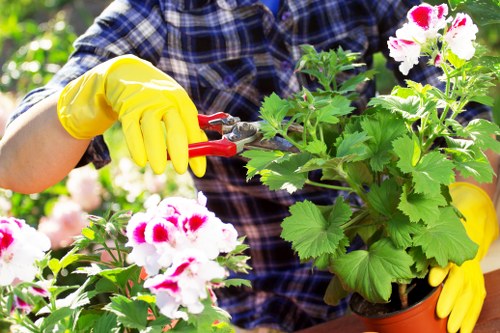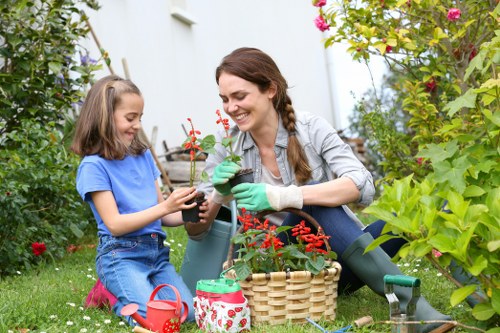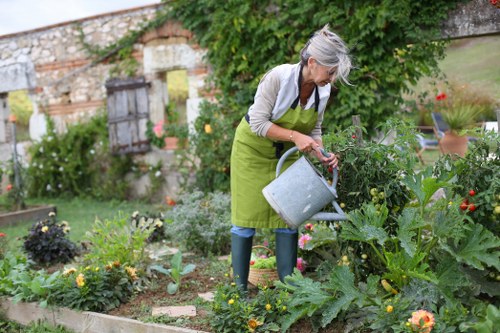Landscape Gardening in Queens Park

Queens Park is a jewel in the heart of the city, offering a serene escape from urban life. Landscape gardening in Queens Park not only enhances the natural beauty of the area but also provides residents with a tranquil environment to relax and enjoy nature.
Whether you're a seasoned gardener or a beginner, creating a stunning landscape garden in Queens Park can be a rewarding endeavor. This guide will walk you through the essential steps and considerations to design a garden that thrives in this specific locale.
From selecting the right plants to incorporating sustainable practices, landscape gardening in Queens Park involves a blend of creativity and practicality. Let’s delve into the key aspects that will help you transform your outdoor space.
Planning Your Landscape Garden

Effective planning is the cornerstone of any successful landscape garden. Start by assessing the existing conditions of your space in Queens Park, including soil type, sunlight exposure, and drainage patterns.
Consider the size and shape of your garden area. Determine whether you want an open layout with expansive lawns or a more structured design with defined flower beds and pathways.
Creating a detailed garden plan will help you visualize the final outcome and identify any potential challenges. Utilize graph paper or garden planning software to sketch your ideas, ensuring that every element has its place.
Assessing Soil and Climate
The soil quality in Queens Park can vary, affecting plant growth and garden health. It’s crucial to conduct a soil test to determine pH levels and nutrient content.
Based on the test results, you may need to amend the soil with compost or other organic matter to improve fertility and structure. Well-prepared soil lays the foundation for a vibrant landscape garden.
Sunlight and Shade Considerations
Understanding the sunlight patterns in your garden is vital. Identify areas that receive full sun, partial shade, or full shade throughout the day.
Choose plants that are well-suited to each light condition to ensure they thrive. Combining sun-loving and shade-tolerant plants can create a diverse and balanced garden ecosystem.

Incorporating zones with varying sunlight exposure adds depth and interest to your landscape design. Utilize structures like pergolas or trellises to provide shade and create microclimates within your garden.
Strategically placing plants based on their light requirements will enhance their growth and overall garden aesthetics.
Additionally, consider the seasonal sunlight variations to maintain a consistently beautiful garden throughout the year.
Selecting the Right Plants

Choosing the appropriate plants is a critical aspect of landscape gardening in Queens Park. Opt for native species when possible, as they are well-adapted to the local climate and soil conditions.
Native plants not only require less maintenance but also support local wildlife, contributing to a healthier ecosystem.
Incorporating a mix of perennials, annuals, shrubs, and trees can add texture, color, and structure to your garden.
Perennials vs. Annuals
Perennials are long-lasting plants that come back year after year, providing stability and continuity in your garden design.
Annuals, on the other hand, complete their life cycle within a year but offer vibrant colors and variety. Combining both can create a dynamic and ever-changing landscape.
Choosing Trees and Shrubs
Trees and shrubs add vertical interest and serve as focal points in your garden. Select varieties that complement the overall design and meet your specific needs, such as providing shade or acting as natural barriers.
Consider the mature size of trees and shrubs to ensure they fit well within the garden space without causing overcrowding.

When selecting trees, opt for species that are resilient to local pests and diseases to minimize maintenance efforts.
Incorporate evergreen trees and shrubs for year-round structure, alongside deciduous varieties that offer seasonal changes in foliage and color.
The right combination of trees and shrubs can significantly enhance the aesthetic appeal and functionality of your landscape garden.
Designing Garden Features
Incorporating various garden features can elevate the overall appeal of your landscape garden in Queens Park. Features such as patios, pathways, water elements, and lighting not only enhance beauty but also add functionality.
Thoughtful placement of these elements can create inviting spaces for relaxation, entertainment, and enjoyment of nature.

Patios and Decks: Create outdoor living areas with comfortable seating, dining spaces, or even outdoor kitchens. Utilize materials that complement the surrounding landscape and withstand local weather conditions.
Pathways: Design winding or straight pathways to guide visitors through your garden. Use materials like gravel, stone, or pavers to add texture and direction.
Water Features: Add tranquility with ponds, fountains, or waterfalls. Water elements can attract wildlife and provide a soothing ambiance.
Outdoor Lighting
Outdoor lighting extends the usability of your garden into the evening hours while highlighting key features. Incorporate a mix of ambient, task, and accent lighting to create a layered effect.
Solar-powered lights are an eco-friendly option, providing illumination without increasing energy consumption.
Garden Structures
Structures like gazebos, pergolas, and arbors add architectural interest and can serve as gathering spots within your garden.
Climbing plants can be trained on these structures, adding greenery and shade.

Seating Areas: Designate areas with benches or chairs for relaxation and contemplation.
Fire Pits: Create a cozy atmosphere with a fire pit, fostering social interactions and warmth during cooler evenings.
Raised Beds: Utilize raised beds for planting, improving soil drainage and making gardening more accessible.
Sustainable Gardening Practices
Embracing sustainable practices in landscape gardening not only benefits the environment but also promotes a healthier and more resilient garden.
Implementing eco-friendly techniques can reduce maintenance efforts and enhance the long-term sustainability of your garden.

Water Conservation: Install rainwater harvesting systems to collect and reuse water for your garden. Drip irrigation systems can efficiently deliver water directly to plant roots, minimizing waste.
Composting: Create a compost bin to recycle organic waste into nutrient-rich soil amendments. Composting reduces landfill waste and enriches your garden’s soil.
Native Plant Selection: As mentioned earlier, native plants require less water and are more resistant to local pests, reducing the need for chemical interventions.
Integrated Pest Management
Adopt integrated pest management (IPM) strategies to control pests naturally. This approach involves monitoring pest populations, promoting beneficial insects, and using organic treatments when necessary.
By minimizing chemical pesticide use, you create a safer and more balanced garden ecosystem.
Soil Health
Maintaining healthy soil is fundamental to sustainable gardening. Regularly add organic matter, such as compost or mulch, to improve soil structure and fertility.
Practicing crop rotation and avoiding over-tilling can prevent soil degradation and promote beneficial microbial activity.

Mulching: Apply mulch around plants to retain moisture, suppress weeds, and regulate soil temperature.
Cover Crops: Plant cover crops during off-seasons to protect and enrich the soil.
Reduced Tillage: Minimize soil disturbance to preserve soil organisms and maintain soil integrity.
Maintenance Tips for a Thriving Garden
Regular maintenance is essential to keep your landscape garden in Queens Park looking its best. Consistent care ensures that plants remain healthy and garden features function properly.
Establish a maintenance schedule that includes watering, pruning, weeding, and monitoring plant health.

Watering: Adjust your watering routine based on seasonal needs and rainfall patterns. Deep watering encourages strong root growth.
Pruning: Regularly trim and shape plants to promote healthy growth and remove any diseased or damaged parts.
Weeding: Keep the garden beds free of weeds to reduce competition for nutrients and maintain a tidy appearance.
Seasonal Care
Different seasons require specific maintenance tasks to ensure garden longevity. In spring, focus on planting and preparing beds, while summer involves managing heat stress and pests.
Autumn is ideal for planting bulbs and preparing plants for winter, and winter maintenance includes protecting plants from frost and pruning dormant growth.
Pest and Disease Management
Stay vigilant in monitoring your garden for signs of pests and diseases. Early detection allows for prompt and effective intervention.
Use organic treatments and natural remedies to address issues, maintaining the health and balance of your garden ecosystem.

Regular Inspections: Conduct routine checks of plants to identify any abnormalities or infestations.
Natural Predators: Encourage beneficial insects, such as ladybugs and spiders, which help control pest populations.
Organic Treatments: Utilize neem oil, insecticidal soaps, or homemade sprays to treat affected plants without harming the environment.
Incorporating Hardscaping Elements
Hardscaping refers to the non-living elements in your garden, such as pathways, walls, fences, and structures. Integrating hardscaping with soft landscaping (plants) creates a balanced and visually appealing garden.
Thoughtful hardscaping enhances functionality and defines different areas within your landscape garden.

Pathways: Design pathways to connect various parts of your garden, guiding visitors through the space.
Walls and Fences: Use walls and fences to provide privacy, define boundaries, and add vertical interest.
Garden Structures: Incorporate pergolas, arbors, and trellises to add architectural features and support climbing plants.
Choosing Materials
Select materials that complement the natural surroundings and withstand local weather conditions. Stone, brick, wood, and metal are popular choices for hardscaping elements.
Consider the maintenance requirements and aesthetic appeal of each material to ensure they align with your garden’s design goals.
Integration with Plantings
Seamlessly integrate hardscaping with plantings by creating transitions and focal points. Use plants to soften the edges of hardscaping elements and blend them into the natural landscape.
Strategically placed plants around structures can enhance their appearance and contribute to the overall harmony of the garden.

Raised Beds and Edging: Define garden beds with edging materials like stone or metal to create clean lines and separate different planting areas.
Seating Areas: Incorporate benches or seating walls to provide comfortable spots for relaxation and enjoying your garden.
Water Features: Integrate fountains or ponds with hardscaping elements to create a cohesive and inviting space.
Enhancing Biodiversity
Promoting biodiversity in your landscape garden benefits both your garden and the local ecosystem. A diverse range of plants attracts various pollinators, birds, and beneficial insects.
Creating habitats for wildlife contributes to a balanced and resilient garden environment.

Pollinator Gardens: Plant flowering species that attract bees, butterflies, and other pollinators.
Bird-Friendly Features: Install birdhouses, feeders, and water sources to encourage birds to visit your garden.
Habitat Creation: Provide shelter for small mammals and insects by incorporating logs, rocks, and native plants.
Native Plant Benefits
Native plants are inherently beneficial to the local environment. They provide essential resources for native wildlife and require fewer resources to maintain.
Incorporate a variety of native species to support a wide range of organisms and enhance the ecological balance of your garden.
Supporting Beneficial Insects
Beneficial insects, such as ladybugs, lacewings, and predatory beetles, help control pest populations naturally.
Planting nectar-rich flowers and providing habitats for these insects encourages their presence in your garden.

Companion Planting: Use companion plants to create mutual benefits, such as attracting beneficial insects or deterring pests.
Habitat Diversity: Create diverse habitats by varying plant heights, structures, and flowering times.
Water Sources: Provide shallow water sources for insects and birds to support their activities.
Seasonal Garden Planning
Designing your landscape garden with seasonal changes in mind ensures year-round beauty and interest. Each season offers unique opportunities to showcase different plants and garden elements.
Careful planning around seasonal cycles helps maintain a vibrant and dynamic garden throughout the year.

Spring: Focus on planting bulbs, early-blooming perennials, and preparing garden beds for the growing season.
Summer: Maintain moisture levels, manage pests, and enjoy the rich colors of summer blooms.
Autumn: Plant fall-blooming plants, clean up garden debris, and prepare for the cooler months.
Spring Strategies
Spring is an ideal time to rejuvenate your garden after winter. Start by clearing any dead plants and debris, then prepare the soil for new plantings.
Introduce early-season bulbs like tulips and daffodils to add vibrant colors as the weather warms.
Summer Maintenance
During summer, focus on regular watering, especially for newly planted areas. Implement mulching to retain moisture and suppress weeds.
Monitor for pests and diseases, addressing any issues promptly to keep your garden healthy.

Autumn Preparations: Plant autumn bulbs, divide perennials, and apply mulch to protect plants from frost.
Winter Protection: Use frost blankets or burlap to shield sensitive plants from harsh winter conditions.
Planning for Next Year: Reflect on the current gardening season and make plans to enhance your garden in the upcoming year.
Utilizing Technology in Landscape Gardening
Technology can greatly assist in managing and enhancing your landscape garden in Queens Park. From garden planning apps to smart irrigation systems, integrating technology streamlines gardening tasks and improves efficiency.
Leverage modern tools to optimize plant care, monitor garden health, and maintain your garden with ease.

Garden Planning Software: Use digital tools to design and visualize your garden layout, making adjustments easily and precisely.
Smart Irrigation: Implement automated watering systems that adjust based on weather conditions, ensuring optimal moisture levels for your plants.
Plant Monitoring: Utilize sensors and apps to track soil moisture, temperature, and light levels, providing real-time data to inform your gardening decisions.
Online Gardening Communities
Join online forums and social media groups dedicated to gardening. These communities offer valuable advice, inspiration, and support from fellow gardening enthusiasts.
Sharing experiences and knowledge can help you overcome challenges and discover new gardening techniques.
Mobile Applications
There are numerous gardening apps available that provide plant identification, care tips, and maintenance reminders. These tools can enhance your gardening efficiency and knowledge.
Find apps that cater to your specific gardening needs, whether it’s plant selection, scheduling, or pest management.

Virtual Tours: Explore virtual garden tours for inspiration and ideas on design and plant combinations.
DIY Projects: Access step-by-step guides for building garden structures, creating compost bins, and other DIY gardening projects.
Educational Resources: Utilize online courses and tutorials to expand your gardening skills and knowledge.
Budgeting and Cost Management
Creating a beautiful landscape garden doesn’t have to break the bank. Effective budgeting and cost management can help you achieve your garden goals within your financial means.
Plan your garden projects in phases, prioritize essential elements, and explore cost-effective solutions to manage expenses.

Cost-Effective Plant Selection: Choose a mix of expensive perennials and affordable annuals to balance cost and visual impact.
DIY Projects: Tackle some garden projects yourself, such as building pathways or constructing raised beds, to save on labor costs.
Reuse and Recycle: Repurpose materials from around your home, like old bricks or pallets, for garden structures and decorations.
Phased Garden Development
Develop your garden in stages to spread out costs and manage your budget effectively. Start with essential elements like planting beds and paths, then gradually add features like water elements and lighting.
Prioritizing projects ensures that your garden remains functional and beautiful even as you expand it over time.
Alternative Sourcing
Purchase plants and materials from local nurseries, garden sales, or plant swaps to find bargains and unique varieties.
Explore online marketplaces for discounted gardening supplies and seeds to reduce costs without compromising quality.

Bulk Purchasing: Buy plants, soil, and mulch in bulk to take advantage of discounts and reduce per-unit costs.
Sales and Discounts: Keep an eye out for seasonal sales and clearance events at garden centers to stock up on supplies.
Seed Starting: Start plants from seeds rather than buying mature plants to save money and expand plant variety.
Final Thoughts on Landscape Gardening in Queens Park
Landscape gardening in Queens Park is a fulfilling endeavor that combines creativity, sustainability, and practicality. By thoughtfully planning your garden, selecting the right plants, incorporating diverse features, and maintaining your space diligently, you can create a beautiful and thriving outdoor sanctuary.
Embrace the unique characteristics of Queens Park, and let your garden reflect the harmony between nature and design.
Ready to transform your outdoor space? Contact us today to start your landscape gardening journey in Queens Park!
